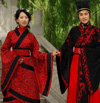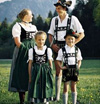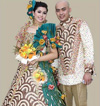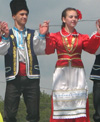Home
 Botswana is a country in Southern Africa that has rich and interesting clothing traditions. Many of them were formed under the influence of colonizers and missionaries who appeared in Botswana in 19-20th centuries. Today traditional Tswana outfit is a mix of Western-style or Victorian Era dresses with the pieces of clothing that are pure Tswana (for example, kaross – traditional blanket made from animal skins). Some costumes of ethnic minorities in Botswana also deserve special attention. We're talking about the Herero dress.
Botswana is a country in Southern Africa that has rich and interesting clothing traditions. Many of them were formed under the influence of colonizers and missionaries who appeared in Botswana in 19-20th centuries. Today traditional Tswana outfit is a mix of Western-style or Victorian Era dresses with the pieces of clothing that are pure Tswana (for example, kaross – traditional blanket made from animal skins). Some costumes of ethnic minorities in Botswana also deserve special attention. We're talking about the Herero dress.
- Details
- Category: Botswana
- Hits: 200306
 There is no traditional costume typical for all the parts of China. Each region has its own features, and sometimes clothing differs completely throughout the country. Another reason for the variety of Chinese outfits is that every Imperial dynasty in China created or refined the traditional clothing to their taste. Though there is one style of clothing which today is considered in the world to be Chinese national costume. It is "hanfu" for men and "qipao" for women.
There is no traditional costume typical for all the parts of China. Each region has its own features, and sometimes clothing differs completely throughout the country. Another reason for the variety of Chinese outfits is that every Imperial dynasty in China created or refined the traditional clothing to their taste. Though there is one style of clothing which today is considered in the world to be Chinese national costume. It is "hanfu" for men and "qipao" for women.
- Details
- Category: China
- Hits: 32210
 The western region of Ukraine covers a part of Carpathian Mountains. Ukrainians who live in highlands are very unique people. They managed to keep their traditions, lifestyle, folklore and many more things till today. They have beautiful songs, special food traditions, rare crafts and, of course, outstanding clothing traditions. The latter didn't change much during last few centuries. The traditional costumes of Carpathian region of Ukraine are bright, richly embroidered garments with extraordinary accessories.
The western region of Ukraine covers a part of Carpathian Mountains. Ukrainians who live in highlands are very unique people. They managed to keep their traditions, lifestyle, folklore and many more things till today. They have beautiful songs, special food traditions, rare crafts and, of course, outstanding clothing traditions. The latter didn't change much during last few centuries. The traditional costumes of Carpathian region of Ukraine are bright, richly embroidered garments with extraordinary accessories.
- Details
- Category: Ukraine
- Hits: 11255
 The national costume of Switzerland is versatile but made in the same style; bright but modest; eccentric but balanced; convenient but beautiful. Such style of clothing is typical for the North Europe. The women's traditional outfit is very feminine, with pretty and extraordinary accessories. The men's folk dress in some regions can be very simple and ordinary, and in other parts of the country, it can look rather aristocratic and stylish. Swiss national clothing was originated from the lifestyle, environment and traditions of Swiss people.
The national costume of Switzerland is versatile but made in the same style; bright but modest; eccentric but balanced; convenient but beautiful. Such style of clothing is typical for the North Europe. The women's traditional outfit is very feminine, with pretty and extraordinary accessories. The men's folk dress in some regions can be very simple and ordinary, and in other parts of the country, it can look rather aristocratic and stylish. Swiss national clothing was originated from the lifestyle, environment and traditions of Swiss people.
- Details
- Category: Switzerland
- Hits: 180343
 For many countries around the world, weapons (especially cold weapons) is a very important part of life. Historically it was a mean of surviving and a serious attribute of everyday life. That's why in a large number of countries, knives, daggers, and swords became a part of a traditional costume. The national attire of Scotland, England, Norway, Finland, Sweden, and Lapland even today contains knives as a full-fledged part of the set. It is rather exciting to compare these knives and to find some peculiarities typical for the certain country.
For many countries around the world, weapons (especially cold weapons) is a very important part of life. Historically it was a mean of surviving and a serious attribute of everyday life. That's why in a large number of countries, knives, daggers, and swords became a part of a traditional costume. The national attire of Scotland, England, Norway, Finland, Sweden, and Lapland even today contains knives as a full-fledged part of the set. It is rather exciting to compare these knives and to find some peculiarities typical for the certain country.
- Details
- Category: Europe
- Hits: 21329
 Bavaria (or the Free State of Bavaria) is the biggest state of Germany. And it is a unique territory which differs from other parts of Germany. People in Bavaria continue to keep their traditions (which are rather long-standing) even today, in the 21st century. Bavarian traditional costume is called "Tracht": "dirndl dresses" for women and "lederhosen" for men. And local people wear them with great proud.
Bavaria (or the Free State of Bavaria) is the biggest state of Germany. And it is a unique territory which differs from other parts of Germany. People in Bavaria continue to keep their traditions (which are rather long-standing) even today, in the 21st century. Bavarian traditional costume is called "Tracht": "dirndl dresses" for women and "lederhosen" for men. And local people wear them with great proud.
- Details
- Category: Germany
- Hits: 66034
 Great exhibition of vintage Ukrainian national garments was held in Kyiv, Ukraine. The exhibits belong to several private collections which are rather rarely shown to the public. There are men's and women's shirts, kersetkas (a kind of women's vest), kerchiefs and other pieces of traditional Ukrainian folk dress. The exhibition represents traditional clothing typical for Central and Western parts of Ukraine.
Great exhibition of vintage Ukrainian national garments was held in Kyiv, Ukraine. The exhibits belong to several private collections which are rather rarely shown to the public. There are men's and women's shirts, kersetkas (a kind of women's vest), kerchiefs and other pieces of traditional Ukrainian folk dress. The exhibition represents traditional clothing typical for Central and Western parts of Ukraine.
- Details
- Category: Ukraine
- Hits: 19526
 Sudan is a large African country with strong Islamic and Christian traditions. Religions and beliefs of local people have a great influence on the national clothing of Sudan. As climate conditions do. Those are the reasons for Sudanese people to wear loose-fitting long attires which cover most of the body. These dresses and robes are made of light natural fabrics. Sudanese people also cover their heads: women with scarves and men with turbans. Headgears serve both for religious purposes and for protection from the sun. Western-style dresses are also used in Sudan, but they're rarer than traditional ones.
Sudan is a large African country with strong Islamic and Christian traditions. Religions and beliefs of local people have a great influence on the national clothing of Sudan. As climate conditions do. Those are the reasons for Sudanese people to wear loose-fitting long attires which cover most of the body. These dresses and robes are made of light natural fabrics. Sudanese people also cover their heads: women with scarves and men with turbans. Headgears serve both for religious purposes and for protection from the sun. Western-style dresses are also used in Sudan, but they're rarer than traditional ones.
- Details
- Category: Sudan
- Hits: 132808
 Filipino national costume is rather colorful, ornate and beautiful. Filipino people lived under the occupation of other countries for centuries. That's why their national attire was formed under the influence of different cultures and got some of their features. The US, Spain, and Japan had the biggest impact on the traditional clothing of the Philippines. But nevertheless, Filipino folk dress is very unique, authentic and even tribal, if we can say so.
Filipino national costume is rather colorful, ornate and beautiful. Filipino people lived under the occupation of other countries for centuries. That's why their national attire was formed under the influence of different cultures and got some of their features. The US, Spain, and Japan had the biggest impact on the traditional clothing of the Philippines. But nevertheless, Filipino folk dress is very unique, authentic and even tribal, if we can say so.
- Details
- Category: Philippines
- Hits: 510712
 Reshetylivka is one of Ukrainian centers of embroidery situated in Poltava region (central part of Ukraine). The embroidery designs typical for Reshetylivka are characterized by unique embroidery techniques. First of all, it is white embroidery on white background. It looks very festive, delicate and even noble. Here are photos from the exhibition "Reshetylivka: in terms of embroidery and weaving" held in Kyiv, Ukraine.
Reshetylivka is one of Ukrainian centers of embroidery situated in Poltava region (central part of Ukraine). The embroidery designs typical for Reshetylivka are characterized by unique embroidery techniques. First of all, it is white embroidery on white background. It looks very festive, delicate and even noble. Here are photos from the exhibition "Reshetylivka: in terms of embroidery and weaving" held in Kyiv, Ukraine.
- Details
- Category: Ukraine
- Hits: 14993
 There are about 250,000 Gagauz people in the world. Most of them live in Europe, approximately 150,000 in Moldova and 50,000 in Ukraine. Also they dwell in Turkey, Russia, Romania, Bulgaria, and even in US and Canada. Despite the small number of people this nation survives and keeps its history, traditions, cuisine, folklore, language, and traditional clothing. Many of their traditions are really interesting and outstanding. In this article you'll read about Gagauz clothing traditions and national costume.
There are about 250,000 Gagauz people in the world. Most of them live in Europe, approximately 150,000 in Moldova and 50,000 in Ukraine. Also they dwell in Turkey, Russia, Romania, Bulgaria, and even in US and Canada. Despite the small number of people this nation survives and keeps its history, traditions, cuisine, folklore, language, and traditional clothing. Many of their traditions are really interesting and outstanding. In this article you'll read about Gagauz clothing traditions and national costume.
- Details
- Category: Europe
- Hits: 13158
 The culture of Crimean Tatars is ancient, rich and interesting. The main crafts are clothes making, weaving, embroidering, pottery, sheep breeding, jewelry and others. Today Crimean Tatar people try to revive their traditional crafts. Many artisans are returning to production clothing (traditional costumes mostly) at home. Handmade clothes, souvenirs and pottery of Crimean Tatars are highly valued in other countries.
The culture of Crimean Tatars is ancient, rich and interesting. The main crafts are clothes making, weaving, embroidering, pottery, sheep breeding, jewelry and others. Today Crimean Tatar people try to revive their traditional crafts. Many artisans are returning to production clothing (traditional costumes mostly) at home. Handmade clothes, souvenirs and pottery of Crimean Tatars are highly valued in other countries.
- Details
- Category: Ukraine
- Hits: 26615
 Saudi Arabian national dress conforms to standards, traditions, climatic conditions and preferences of local people. That's why Saudis choose traditional clothing, not Western style of attire. Also the Kingdom of Saudi Arabia refers to the Muslim world, and the national costume shows it. Saudi people are conservative in clothing, family relationships, religion and way of life in general.
Saudi Arabian national dress conforms to standards, traditions, climatic conditions and preferences of local people. That's why Saudis choose traditional clothing, not Western style of attire. Also the Kingdom of Saudi Arabia refers to the Muslim world, and the national costume shows it. Saudi people are conservative in clothing, family relationships, religion and way of life in general.
- Details
- Category: Saudi Arabia
- Hits: 282705
 The collection of photographs belongs to Ukrainian center of folk culture "Ivan Honchar Museum". These photos were taken from the historical and ethnographic album "Ukraine and Ukrainians". The photos show traditional Ukrainian clothing from different regions. They were made in the end of 19th and the beginning of 20th century. The main characters of photo collection are ordinary people and families. All photos are in original vintage frames.
The collection of photographs belongs to Ukrainian center of folk culture "Ivan Honchar Museum". These photos were taken from the historical and ethnographic album "Ukraine and Ukrainians". The photos show traditional Ukrainian clothing from different regions. They were made in the end of 19th and the beginning of 20th century. The main characters of photo collection are ordinary people and families. All photos are in original vintage frames.
- Details
- Category: Ukraine
- Hits: 7983
Page 67 of 70
